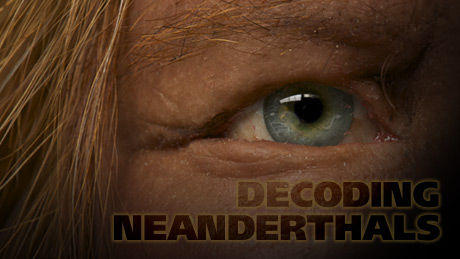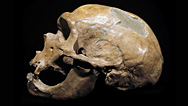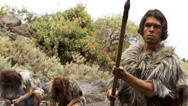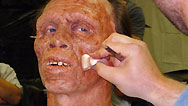
Decoding Neanderthals
Shared DNA reveals a deep connection with our long-vanished human cousins. Airing January 9, 2013 at 9 pm on PBS Aired January 9, 2013 on PBS

Program Description
Transcript
Decoding Neanderthals
PBS Airdate: January 9, 2013
NARRATOR: They were the brutes of Ice Age Europe. Although a branch of our human family tree, they were seen as a dead end, deep in our prehistoric past. They were called Neanderthals.
JOHN HAWKS (University of Wisconsin): Neanderthals have the mother of all image problems.
NARRATOR: They eked out a marginal existence, hunting by brute force, with only simple stone tools. They were considered primitive, with no language, art, or the higher-level thinking of advanced species, like us.
APRIL NOWELL (University of Victoria): They lacked the same intelligence as modern humans.
NARRATOR: They began to disappear 40,000 years ago, as modern humans, our species, came on the scene. But this primitive picture is being replaced by a different image of Neanderthals. It's bringing them much closer to us, as genetic evidence revises our human family tree and reveals their mysterious presence, right within our genes.
ED GREEN (University of California, Santa Cruz): We started to look at the problem from different angles, and the answer would come back, "It's Neanderthal."
SVANTE PÄÄBO (Max Planck Institute): That was, sort of, quite shaking to me. I thought this must be a statistical fluke.
NARRATOR: Now, archaeologists are finding new evidence to help resolve bitter debates.
JOAO ZILHAO (University of Barcelona/ICREA): This is the smoking gun. We have here the case to settle the controversy.
NARRATOR: In tool-making, they're seeing signs of language.
METIN I. EREN (University of Kent): There's some sort of advanced talking going on.
NARRATOR: A new Neanderthal mind emerges.
WIL ROEBROEKS (Leiden University): We're not talking about idiots.
NARRATOR: And if scientists are finally finding the real legacy of the Neanderthals buried deep in our history and our genes, what does it say about all of us?
Decoding Neanderthals, right now, on NOVA.
Forty-thousand years ago, Europe is in the grip of an Ice Age. In harsh, unforgiving terrain live members of an ancient human species, the Neanderthals. It is a brutal time to be alive, only the toughest survive.
CHRIS STRINGER (University of Colorado): They were very muscular, short, wide, very stocky, very powerfully built.
THOMAS WYNN (University of Colorado): They were hunter-gatherers; they had scarce game to find. Most Neanderthals were probably dead by 30 years old. It was a brief brutal life.
NARRATOR: Hunting was extremely dangerous.
CHRIS STRINGER: They were confrontational hunters, so they had to get close to their prey with stabbing spears. This required not only a lot of bravery, but a lot of physical strength.
FREDERICK L. COOLIDGE (University of Colorado): These Neanderthals could bench-press 300 to 500 pounds. They had big thrusting spears that they threw into the sides of 300-pound animals.
NARRATOR: The Neanderthals survived the harsh conditions in Europe for at least 300,000 years. Then around 40,000 years ago, a different human species arrives on the scene, our species, Homo sapiens. They migrated from Africa, spreading across Neanderthal territory, outnumbering them 10 to one.
CHRIS STRINGER: Suddenly, you've got two species competing for the same resources: hunting the same animals, collecting the same plant resources, wanting to live in the best territories and the best caves.
NARRATOR: After another 10,000 years, the Neanderthals disappear.
ED GREEN: The story of the Neanderthals is a murder mystery. They were there, and now they're gone, and they go away at about the same time that we are showing up on the scene.
NARRATOR: So why did they vanish, while we survived? For years, many scientists believed we wiped them out: a simple case of our brain out-classing their brawn. This theory emerged when archaeologists unearthed the very first Neanderthal skulls, over 150 years ago. To scientists at the time, skulls like these looked primitive compared to ours.
Chris Stringer is one of the world's preeminent Neanderthal experts.
CHRIS STRINGER: We can tell a Neanderthal skull 100 percent of the time. They've got a very broad skull, this double-arched brow ridge and, perhaps their most distinctive feature, the middle of the face is pulled forwards, their cheekbones swept back.
NARRATOR: One influential discovery featured a skeleton crippled by acute arthritis, incorrectly reconstructed with a hunched posture and a shuffling walk. This early find helped shape popular perceptions of Neanderthals for decades, launching a wave of images of the Neanderthal as a brutish caveman.
JOHN HAWKS: Neanderthals have the mother of all image problems: "They're brooding, they're stupid-looking, they have no personality."
CHRIS STRINGER: They were reconstructed as being much more apelike, much more bestial: grasping big toes, very hairy, head hung forward, shambling in their gait.
NARRATOR: Critically, scientists believed the Neanderthals lacked the one thing that defines us: our brainpower.
APRIL NOWELL: They lacked the same intelligence as modern humans.
NARRATOR: With only limited stone tools and no art or personal ornaments, Neanderthals seemed less advanced than modern humans. But was that really the whole story?
Now, new discoveries in genetics and archaeology are challenging this traditional view of the Neanderthals.
Metin Eren has spent six years studying Neanderthal technology. These "Levallois flakes," named after the place in France where they first found, were the Neanderthals' tool of choice. At first glance, they look rudimentary, the product more of luck than judgment. But when Eren tried to reproduce one, he got a surprise.
METIN EREN: I can tell you, just from my personal experience, I find the Levallois technology much more difficult to make than any of the modern Homo sapiens technologies. You know, it took me about 18 months to master Levallois technology, and this was after I'd been flint-napping for a number of years. The fact that there seems to be a goal involved…they're not simply striking flakes to get a sharp cutting edge.
NARRATOR: Eren began to realize this was no hit and miss process. He wanted to discover just how they did it. So he turned to morphometrics, a technique which analyzes the exact shapes and angles of objects.
It revealed Neanderthals must have used a precise set of strikes to turn a raw flint block into a carefully-shaped object, known as the core. The final crucial step involved striking the core with a single precision blow. Only if aimed just right, would this create the perfect flake, and a remarkably versatile tool.
METIN EREN: I shape this in such a way so that the core has a gentle convexity, so that the large flake that comes off has a sharp edge all around this perimeter. That enhances its utility in a number of ways.
Because it's uniformly thick, you can re-sharpen it a number of times more than you can other types of stone flakes.
We also found the Levallois flake is statistically more symmetrical, so that when you use it, it basically reduces torque. It has ergonomic properties. I can actually get a lot more force with each cut and each slice. I just put a little more pressure, and the Levallois flake goes right through it and that one big piece of gammon. That took about a minute and a half.
This is an amazing tool. They were engineering their rocks to get particular products that have specific properties. That they were able to discover a technique that is incredibly difficult to do is just a testament to how intelligent they must have been to actually invent it in the first place.
NARRATOR: Metin Eren's work reveals the complexity of Neanderthal tool-making, but there's even more surprising evidence of sophisticated Neanderthal technologies.
Dutch archaeologist Wil Roebroeks is studying new finds, one of them dating back a quarter of a million years. This is a flint spearhead: at its base, a large sticky black mass, most likely used as a glue. Evidence from many sites had already shown how Neanderthals attached stone flakes to wooden shafts, first binding them with sinew or leather, then securing the binding with a glue-like substance. This turned the flake and its shaft into a robust weapon.
WIL ROEBROEKS: What you see is a nice razor-sharp flint flake, which is covered at the base in this pitch material. It's a material that was probably used in many aspects of everyday life.
NARRATOR: At first, it was thought this Neanderthal glue was nothing more than sap from a pine tree, easy for them to find and use. But detailed analysis revealed something different. It was a type of manmade pitch, from birch trees.
WIL ROEBROEKS: Chemical studies have shown that that material was produced by heating birch bark. Neanderthals were producing these pitches. So it is not something like the stuff you can retrieve from a pine when you hit a tree, that's the natural stuff that comes out. But this is something, this is another material. It's a synthetic, produced by Neanderthals a quarter of a million years ago.
NARRATOR: This is the world's oldest-known synthetic material. It makes Neanderthals, and not us, the inventors of perhaps the first industrial process. But how could an allegedly primitive species have done this?
To find out more, Wil Roebroeks decides to mount an experiment with a colleague, Friedrich Palmer. They will try to replicate the Neanderthal technique of pitch extraction, a complex process called "dry distillation."
Crucially, they'll use only the materials available to Neanderthals 250,000 years ago: an upturned animal skull to catch the pitch; a small stone on which the pitch would condense; some rolls of birch bark, the source of the pitch; and a layer of ash to exclude oxygen and prevent the bark from burning.
Roebroeks and Palmer need to heat the bark to 400 degrees centigrade. Any less, and it won't produce pitch; any more, and it will simply burn.
After eight hours, any pitch should have condensed on the stone within the skull. Today, Roebroeks and Palmer manage to extract only a tiny smear of pitch. They are on the right track, but it isn't nearly enough to glue a spearhead to a shaft, as the Neanderthals did.
FRIEDRICH PALMER: It's sticky.
WIL ROEBROEKS: It's not much. It's very small quantities.
NARRATOR: It seems this experiment is on too small a scale to produce enough pitch. Neanderthals must have figured out how to scale up the technique in a way we haven't yet reproduced.
However they managed it, the Neanderthals had evidently mastered a complex thermal process. The Neanderthals' extraction of pitch and their distinctive tool-making, suggest their technology was more advanced than previously thought. What's more, artifacts like these have been found across a wide area of Europe. And this raises a question: how did Neanderthals communicate these complex ideas? Could it be they shared that one ability we usually think of as unique to us: language?
WIL ROEBROEKS: One could infer that there was some communication, maybe, between generations or between peers in a group. But language, of course, is very difficult to excavate.
NARRATOR: Now, fresh evidence is emerging from a completely different branch of science, applied to Neanderthal research for the first time. Svante PÄÄbo is one of a new breed of detectives examining our deepest past. He's not an archaeologist; he does his digging in the lab.
PÄÄbo is interested in humans and what sets us apart from our closest relatives. As a geneticist, his work involves comparing our genetic material with that of the rest of our family tree.
SVANTE PÄÄBO: It's really about finding out what makes us special in the world, what made things such as modern humans spreading across the entire globe, developing all the technology, all the culture that's typical in moderns.
NARRATOR: PÄÄbo and his colleagues wanted to look at specific genes, where you'd expect humans and our closest relatives to differ, like a gene fundamental for language, named FOXP2.
ED GREEN: FOXP2 is a very interesting gene in that it's one of the few genes directly related to this uniquely human characteristic: speech and language.
NARRATOR: FOXP2 is found in many species, although the human version is distinctive. By comparing it with a potential Neanderthal version, PÄÄbo was hoping to shed light upon what makes human language special. But before he could even begin, PÄÄbo needed to have the genetic blueprint for both Neanderthals and humans, their genomes.
A genome is the distinctive genetic recipe for a species, made up of a specific set of chromosomes. These are responsible for the characteristics that make every species different. Within the chromosomes, genes determine whether we have two legs or four, grow feathers or fur. And every part of this unique recipe is encoded within just one molecule: D.N.A.
When Svante PÄÄbo started his work, the human genome had already been decoded. No one had attempted to map the Neanderthal genome. PÄÄbo faced a seemingly impossible task in attempting to map the D.N.A. in the nucleus of a 30,000 year old cell.
Ed Green is a geneticist on PÄÄbo's team.
ED GREEN: As soon as this was obvious, that this was possible, in theory, we started to think about how do we do this in practice, if we can get nuclear data, if we can get some amount. And we did some back of the envelope calculations and thought, yes, this was feasible.
SVANTE PÄÄBO: We spent a lot of time looking at many archaeological sites and many different bones and, eventually, identified this site, in Croatia.
NARRATOR: The Vindija cave in northern Croatia contained genetic gold dust: the 30,000-year-old leg bone fragments of three female Neanderthals. The exceptionally well-preserved bones offered PÄÄbo's team the best chance of extracting Neanderthal D.N.A.
In sterile conditions, the team took samples of bone, carefully dissolving them in solution, before spinning them, at high speed, in a centrifuge, to retrieve the strands of D.N.A.
But then the real difficulties began. The bone samples carried billions of unwanted passengers.
SVANTE PÄÄBO: Most bones we looked at might contain a few molecules of Neanderthal D.N.A., but the vast, vast majority come from bacteria and fungi that colonize the bones, when it was in the ground or in a cave, for tens of thousands of years.
NARRATOR: Before the team could go any further they'd have to destroy the rogue D.N.A. So they invented a cleanup technique, using enzymes that specifically target and eliminate the bacterial D.N.A. from the sample.
The resulting clean sample contained five-times the concentration of Neanderthal D.N.A., compared to the original, which made the analysis easier.
Still, reconstructing the genome remained a formidable challenge. The D.N.A. molecule's intertwining strands are held together by four key chemicals, represented by letters. These bond together as pairs, always C to G and A to T. These letters are like building blocks, repeating units which spell out the genome's unique recipe.
Their order is critical. Just one letter out of place within three-billion pairs, and the genome would be inaccurate. But the D.N.A. was in tiny fragments, like a colossal jigsaw puzzle.
The team would have to place each piece in precisely the right order.
ED GREEN: Svante and others were very skeptical. It was in the realm of the impossible that the genome would ever be sequenced.
SVANTE PÄÄBO: During the course of this project, there were actually many times when we despaired about being able to make it.
NARRATOR: It would take them four years, but finally, the last piece of the puzzle fell into place.
ED GREEN: Human evolution is something everyone cares about, and it's such an incredible thing, technically, to be able to do. Add to that it's our closest extinct ancestor and all that it can tell us about evolution and human biology: it's the most exciting thing I've ever worked on.
NARRATOR: This is the result of all their work: the Neanderthal genome.
Here is one tiny part of the actual sequence of over three-billion letters, corresponding to each D.N.A. building block: the genetic blueprint of a species of human that became extinct 30,000 years ago.
Now, at last, PÄÄbo's team could begin comparing Neanderthal to modern human genes.
One of the first areas they looked at was FOXP2, the gene associated with language. Would an identical gene be shared between human and Neanderthal? Would the gene be there at all?
SVANTE PÄÄBO: To my surprise, I must say, it turns out it is shared.
NARRATOR: Neanderthals had exactly the same version of the FOXP2 gene as humans, the same chemical letters in exactly the same order.
SVANTE PÄÄBO: I'm very sure that the Neanderthals had communication. If it was a language exactly as we would understand language, that's another question.
CHRIS STRINGER: I think Neanderthal language was a more practical language, it was a day-to-day language.
NARRATOR: PÄÄbo's work adds weight to the growing argument that Neanderthals and modern humans shared more abilities than previously thought. It begged a billion dollar question: did we have enough in common that we could have interbred?
If Neanderthals and modern humans had interbred successfully, traces of their D.N.A. would be found in ours. Most scientists, PÄÄbo included, thought this highly unlikely.
When different species mate, their offspring are usually infertile.
SVANTE PÄÄBO: I was biased against interbreeding. There is no evidence for it, so I don't think it really happened.
NARRATOR: But with the Neanderthal genome now sequenced, PÄÄbo and his team could examine this question. The first step was to map the individual genomes of five people from different ethnic groups. Then they compared this modern D.N.A. with the Neanderthals'.
They focused only on small specific regions, called variable areas, where the order of the D.N.A. letters often differs from one individual to the next. Here, if interbreeding had taken place, letter sequences typical of Neanderthal D.N.A. would show up in the human D.N.A. strand, but with no interbreeding, there would be no trace of Neanderthal D.N.A. in the variable areas.
PÄÄbo expected to see the same negative result in the genomes of all five modern humans, regardless of ethnic group.
ED GREEN: Well, if Neanderthals are equally distantly related to everybody, the Neanderthal should match the French guy and the West African guy equally often.
NARRATOR: But that is not what they found.
SVANTE PÄÄBO: When we compared one African to a European individual, the Neanderthal matched the European individual more often than the African.
NARRATOR: The result indicated that Neanderthals were genetically closer to Europeans and Asians than they were to Africans. It meant that somewhere along the line, European and Asian humans had picked up Neanderthal D.N.A.
SVANTE PÄÄBO: So, that was, sort of, quite shaking to me. I thought this must be a statistical fluke. It was not quite significant; this would surely go away when we have more data.
NARRATOR: So PÄÄbo told his team to do the work again and again and again.
SVANTE PÄÄBO: We really needed to make absolutely sure we were right.
ED GREEN: We started to look at the problem from different angles. Every time we would ask the question in a little bit different way and the answer would come back, "It's Neanderthal."
We were able to convince one another and, eventually, the world, we have a little bit of Neanderthal ancestry in modern human genomes.
NARRATOR: The amount of Neanderthal D.N.A. in these modern genomes is small, between just one and four percent, but the implications are staggering: after migrating out of Africa, early humans must have mated with Neanderthals and produced fertile offspring, who inherited segments of Neanderthal D.N.A.
SVANTE PÄÄBO: What we have shown, clearly, is that we could interbreed with them, we could have fertile children, and at least some of those children became incorporated in the human community and reproduced and contributed to present day humans.
NARRATOR: PÄÄbo's groundbreaking research forces a radical shift in perspective regarding Neanderthals. They were genetically close enough to have children with our species. They probably also had language.
And there are yet more revelations, as archaeologists re-examine previously discounted evidence in favor of Neanderthal skills and abilities.
A hallmark of our species is our age-old affinity for art, ritual and adornment.
JOAO ZILHAO: We see the astonishing cave art; we see statuettes over the range of modern humans from Western Europe to Siberia. And I think that's part of the fact that modern humans are entering new territories. They're covering wide distances, and they're having to signal and network with each other.
NARRATOR: Communicating with others through art and ritual has long been considered a uniquely human trait.
JOAO ZILHAO: People have always thought that Neanderthals were not quite like modern humans, and there has been the notion that perhaps Neanderthals were less intelligent. And one way archaeologists have to deal with this question is by assessing the extent to which people used symbols.
NARRATOR: Evidence of Neanderthal symbolism has been elusive, until recently. This is one of many fragments of manganese dioxide, a black mineral, found in a Neanderthal cave in France. Its tip is worn down, as if used as a crayon.
In Neanderthal sites in Gibraltar, archaeologists have discovered cut marks on the wing bones of crows and birds of prey, bones with little value as food. The marks suggest Neanderthals were cutting off the feathers and using them to decorate their hair or bodies.
And in Spain, seashells have revealed faint traces of hematite or iron ore, a red mineral often used as pigment. Neatly-pierced holes allow the decorated shells to be worn as ornaments.
Anthropologist Joao Zilhao believes the evidence offers a glimpse into the Neanderthal mind. Now, he is reexamining finds from a Neanderthal site in Spain, excavated in the '80s.
JOAO ZILHAO: This is a fragment of a naturally pointed horse bone, and when we looked at the tip of the bone under the microscope we found reddish dots.
NARRATOR: Although so faded they are hard to see, the chemical analysis proves the spots are to be the red pigment, hematite.
And there is more.
JOAO ZILHAO: This shell is from the Mediterranean oyster, and you can see, adhering to the inner side of the shell, remnants of a pigment, which is black and reflective.
NARRATOR: Zilhao has found a pencil-like sliver of bone with a red mineral at its tip, and a shell stained with a shiny pigment, alongside other fragments of colored minerals. It adds up to a significant collection, or so Zilhao believes.
JOAO ZILHAO: You know these just look like, you know, shells collected at the beach, but the amount of information they contain is tremendous.
NARRATOR: Putting all the pieces of the puzzle together, Zilhao is convinced he's looking at the remains of a Neanderthal body-painting kit.
JOAO ZILHAO: This suggests what was being prepared in this shell was a cosmetic preparation, and it suggests that this was a tool to prepare or apply something like glitter makeup.
This is the smoking gun. We have here the case to settle the controversy of Neanderthal symbolism.
NARRATOR: Zilhao believes Neanderthals used body paint as a symbolic way of distinguishing friend from foe, just as we do today.
JOAO ZILHAO: It's like when you go to a football stadium and there are two teams playing. How do you know whether you're safe to sit next to someone who may be supporting the team that hates yours? You use an artifact that identifies you as a supporter. And it's this kind of information about yourself that these kind of objects transmit.
NARRATOR: But even if the Neanderthals were painting themselves and engaging in symbolic behavior, does it mean they thought the same way as modern humans? Our modern human ancestors practiced ritual and religion.
Similar evidence for Neanderthals has been elusive. Then a team of archaeologists made an intriguing discovery in southern Spain. Their finds hint at the existence of a Neanderthal ritual.
Inside this cave, a team, led by Michael Walker, excavated a deep shaft, in which they found more than 300 bones from around 10 Neanderthals, buried by rock falls from the unstable ceiling.
Three of the Neanderthals stood out. Walker thinks they weren't necessarily the victims of a rock fall.
MICHAEL WALKER (University of Murcia): If there are rocks falling on you from a natural rock fall, it would be very strange to find nobody trying to escape. And one of them is with the hands close to the head, in almost sleeping position.
NARRATOR: Although the bones of this young female are fused to the limestone rock and are hard to see, Michael Walker thinks her body may have been carefully arranged in a fetal position.
If he's right, this was no rock fall. Around 50,000 years ago, someone had intentionally buried her, piling stones to protect her body.
And this cave had yet more to reveal. Near to the girl's body, Walker's team uncovered the fossilized bones of a pair of panther paws.
MICHAEL WALKER: This articulated paw of a panther was found close by. And since the panther hadn't eaten and disturbed the bones here, it's more likely the Neanderthals disturbed the panther and cut its paw off.
I just wonder whether, in the way that hunters in America cut off bear paws, I'm just wondering whether Neanderthals cut off the panther paw and kept it as a trophy.
NARRATOR: Walker's idea that the severed panther paws were a trophy or funeral offering is an intriguing speculation.
CHRIS STRINGER: I think that there are enough examples of Neanderthal burials to suggest that they are intentionally burying their dead. Perhaps when you come to the issue of grave goods and whether they're putting material into those graves and whether they are sending message beyond the grave with these materials, that's more controversial.
FREDERICK COOLIDGE: You see, in humans, elaborate ritual burials, maybe about 27,000 years ago, the clearest evidence, in this place, in Russia, where these children are buried with, like, 10,000 beads. There's nothing like that in Neanderthal burials.
NARRATOR: Whether Neanderthal burials are evidence of complex rituals and beliefs is hotly debated. But many clues now point to the idea that Neanderthals were more accomplished and advanced than previously thought. And this opens up perhaps the biggest question of all: why are we still here and Neanderthals are not?
The Neanderthals' story seems simple. Their forerunners reach Europe around 800,000 years ago. When Homo sapiens joins them, around 40,000 years ago, it marks the beginning of the end. Some 10,000 years after modern humans arrive, virtually all traces of Neanderthals are gone.
Some scientists believe we drove them into extinction, by outcompeting them for scarce resources, maybe even by killing them, but the latest evidence points to another possibility.
Soon after Svante PÄÄbo's team revealed that Neanderthals and modern humans outside Africa had interbred, anthropologist John Hawks re-opened the case files. He wanted to know if this interbreeding had happened a little or a lot.
To find out, Hawks needed more than just the five modern human genomes that PÄÄbo had analyzed, and he got a lucky break. A team of scientists published a huge new database of individual human genomes from around the world.
JOHN HAWKS: The 1000 Genomes Project data began to become available, and so we were able to expand the comparison to, literally, more than a thousand from different populations.
NARRATOR: If interbreeding had been a relatively rare event, then all non-African humans, across the world, would have inherited the same small dosage of Neanderthal D.N.A., but that's not what Hawks found.
JOHN HAWKS: Now, my lab, we were able to look at more people in China, more people in Tuscany, the U.K. And as we're doing that, we're discovering there are some differences among these populations.
NARRATOR: Hawks uses the jelly beans to illustrate the relative percentages of Neanderthal D.N.A. he found in different groups of modern humans across the world.
JOHN HAWKS: We see that in China there is a little less; in Europe, it's a little more. And when we compare Europeans, in southern Europe, in Tuscany, it's a little more than it is in other areas of Europe.
NARRATOR: Outside Africa, Hawks' data showed the Chinese have the smallest dose of Neanderthal D.N.A., some individuals having as little as two percent. But in Tuscany, northern Italy, in some cases, this rises to around four percent. So, Hawks' data shows that Tuscans have more Neanderthal genes than any other people living today.
If Hawks is right, Ice Age southern Europe was a hotbed of Neanderthal-human interbreeding.
JOHN HAWKS: This was Neanderthal habitat. Modern humans were interbreeding with them, for a longer time and over a larger geographic space, and subsequently, Europeans got a little bit more Neanderthal D.N.A.
NARRATOR: Today, a simple blood test can estimate how much of our genetic identity is Neanderthal.
JOHN HAWKS: Okay, do you guys want to find out? Are you sure you're ready?
At 1.3 percent is Arial. That's very characteristic of Afro-Americans in our sample. Next, at 2.5 is Vang. And the most…you're left, how much do you think it is?
GIRL: No more than three percent.
JOHN HAWKS: Not five?
GIRL: I hope not.
JOHN HAWKS: All right. You're the most, with three percent.
NARRATOR: This field of research is in its infancy and evolving rapidly. Other experts report different percentages of Neanderthal D.N.A., but most agree on one key finding: there wasn't just a handful of sexual encounters between humans and Neanderthals, but many. That presents a dramatically different picture of how human and Neanderthal interacted in Ice Age Europe, and leads to a new outlook on the Neanderthals' disappearance.
JOHN HAWKS: When we think about the process of extinction in other kinds of animals, we think of it, usually, as really sudden, like, an asteroid hits the earth and they're gone. With the Neanderthals, you're looking at a much more gradual process, a process that unfolded over thousands of years.
NARRATOR: Hawks believes the Neanderthals' D.N.A. was absorbed by the dominant population. Outnumbered 10 to one by modern humans, Neanderthals weren't hunted to extinction by a supposedly superior species; they were bred out, genetically swamped.
JOHN HAWKS: I would frame the end of the Neanderthals as a process of interaction and absorption. The Neanderthals were, sort of, on the losing end of that. Their only route to success was probably breeding with our population.
NARRATOR: But is our dosage of Neanderthal D.N.A. just a quirk of genetic history, or is there a serious side to this inheritance? What, if anything, have Neanderthals done for us?
Ed Green and his team are looking closer at the sections of Neanderthal D.N.A. that we inherited.
ED GREEN: One obvious follow up question is what is the impact of Neanderthal genetic contribution into people today?
NARRATOR: Most of the genes they examine don't have any known function, but then the team finds something intriguing: Neanderthal D.N.A. in locations fundamental to our immune system, involving genes that are vital to our ability to fight off disease.
These areas are called human leukocyte antigens or H.L.A.s. They make the cells that attack viruses and bacteria. Since Neanderthals lived in Ice Age Europe for hundreds of thousands of years, their immune systems must have been specially adapted to fight off the diseases there. This was something that modern humans, arriving from Africa, didn't have.
JOHN HAWKS: It's absolutely a survival toolkit. H.L.A. types are important because they help our body resist disease.
ED GREEN: Our ancestors, when they came into the Neanderthal range, were, for the first time, encountering this environment. Our immune systems would not be adept at recognizing and fighting pathogens new to us.
JOHN HAWKS: So it's very clear that one product of this interaction was the inheritance of immune system versions of genes.
ED GREEN: Maybe they confer some selective advantage. Maybe Neanderthals have a version of these immune system genes that were beneficial for the Neanderthal, and they were beneficial to the human people who got these genes by interbreeding.
NARRATOR: This is the Epstein-Barr virus, linked to both mononucleosis and a type of blood cancer. Ed Green's team found that an H.L.A. we inherited from Neanderthals could reduce the risk of contracting this deadly virus. But this may be just the tip of the iceberg.
JOHN HAWKS: As we look more and more at the Neanderthal genome and characterize what things are where, I think we're going to find more of these.
NARRATOR: It seems the Neanderthals who mated with our human ancestors may have given their offspring a lifesaving legacy, a legacy that is potentially saving lives, even to this day.
The genetic and archaeological evidence is still unfolding, but already it is telling us something profound. The Neanderthal story goes to the heart of who we are today. We're finding out we owe a debt to a mysterious, long-vanished branch of the human family, in ways we are only just beginning to discover.
Broadcast Credits
- EXECUTIVE PRODUCERS
- Alison Turner
Tom Brisley - DIRECTED BY
- Nick Clarke Powell
- PRODUCED BY
- Johanna Woolford Gibbon
Ben Harding - CONSULTANT
- Matthew Barrett
- EDITED BY
- Sebastian Duthy
- CAMERA
- Chris Openshaw
Richard Numeroff - SOUND RECORDISTS
- Steve Theroux
Steve Roseboom
Hayden Jackson
Grant Lawson - NARRATED BY
- Lance Lewman
- ASSISTANT CAMERA
- Dave Prevost
- MUSIC
- David Hamill
Audio Network
Extreme - ANIMATION
- Bandito VFX
Pixeldust Studios - PRODUCTION MANAGER
- Stephanie Mavropoulos
- ONLINE EDITOR
- Chris Clark
- COLORIST
- Ross Baker
- AUDIO MIX
- Danny Finn
- SOUND EDITOR
- Graham Kirkman
- RESEARCH
- Rosie Waldron
Camila Ruz - PRODUCTION COORDINATOR
- Sarah Kinsella
- ARCHIVAL MATERIAL
- CanStockPhoto
Corbis
Didier Descouens, Museum of Toulouse
Getty Images
iStockPhoto
Jiri Hochman
Max Planck Institute
Mesa Verde National Park
Plos-One
Pond5
Joao Zilhao
Science Photo Library
Sebastian Duthy - Shutterstock
- Tomislav Kranjcic
Università di Firenze - SPECIAL THANKS
- Klara Parmova
Jontxu Portusiano Hastalamedula - NOVA SERIES GRAPHICS
- yU + co.
- NOVA THEME MUSIC
- Walter Werzowa
John Luker
Musikvergnuegen, Inc. - ADDITIONAL NOVA THEME MUSIC
- Ray Loring
Rob Morsberger - POST PRODUCTION ONLINE EDITOR
- Spencer Gentry
- CLOSED CAPTIONING
- The Caption Center
- MARKETING AND PUBLICITY
- Karen Laverty
- PUBLICITY
- Eileen Campion
Victoria Louie - SENIOR RESEARCHER
- Kate Becker
- NOVA ADMINISTRATOR
- Kristen Sommerhalter
- PRODUCTION COORDINATOR
- Linda Callahan
- PARALEGAL
- Sarah Erlandson
- TALENT RELATIONS
- Scott Kardel, Esq.
Janice Flood - LEGAL COUNSEL
- Susan Rosen
- DIRECTOR OF EDUCATION
- Rachel Connolly
- DIGITAL PROJECTS MANAGER
- Kristine Allington
- SENIOR DIGITAL EDITOR
- Tim De Chant
- DIRECTOR OF NEW MEDIA
- Lauren Aguirre
- PRODUCTION MANAGER
- Stephanie Mills
- POST PRODUCTION ASSISTANT
- Brittany Flynn
- POST PRODUCTION EDITOR
- Rebecca Nieto
- POST PRODUCTION MANAGER
- Nathan Gunner
- COMPLIANCE MANAGER
- Linzy Emery
- BUSINESS MANAGER
- Elizabeth Benjes
- DEVELOPMENT PRODUCER
- David Condon
- PROJECT DIRECTOR
- Pamela Rosenstein
- COORDINATING PRODUCER
- Laurie Cahalane
- SENIOR SCIENCE EDITOR
- Evan Hadingham
- SENIOR PRODUCERS
- Julia Cort
Chris Schmidt - SENIOR SERIES PRODUCER
- Melanie Wallace
- MANAGING DIRECTOR
- Alan Ritsko
- SENIOR EXECUTIVE PRODUCER
- Paula S. Apsell
A NOVA Production by Arrow International Media Ltd. for WGBH
© 2013 WGBH Educational Foundation
All rights reserved
Image
- (sculpted model female Neanderthal)
- © Mark Thiessen/National Geographic Society/Corbis
Participants
- Frederick Coolidge
- University of Colorado
- Metin Eren
- University of Kent, Canterbury
- Ed Green
- UC Santa Cruz
- John Hawks
- University of Wisconsin-Madison
- April Nowell
- University of Victoria, Canada
- Svante Pí¤í¤bo
- Max Planck Institute, Leipzig
- Wil Roebroeks
- Archaeologist, Leiden University
- Chris Stringer
- Anthropologist
- Michael Walker
- University of Murcia, Spain
- Thomas Wynn
- University of Colorado
- Joao Zilhao
- University of Barcelona/ICREA
Preview | 00:30
Full Program | 53:07
Full program available for streaming through
Watch Online
Full program available
Soon














